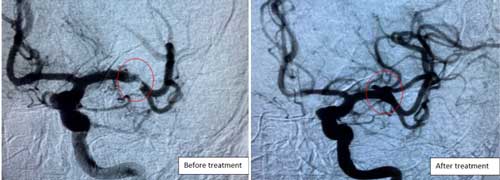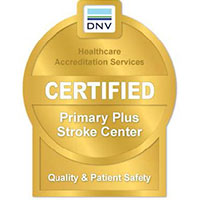Stroke awareness: Why your health can’t wait
May 11, 2021Quickly recognizing symptoms and seeking care can help effective treatment
 TUCSON – Every minute counts for quickly getting treatment when blood supply to part of the brain is blocked or when a blood vessel in the brain bursts.
TUCSON – Every minute counts for quickly getting treatment when blood supply to part of the brain is blocked or when a blood vessel in the brain bursts.
Knowing the signs and symptoms of stroke are important. Stroke affects more than 795,000 people in the U.S. each year, but it is preventable and treatable, according to Misty Thompson, stroke coordinator at the Carondelet Neurological Institute at St. Joseph’s Hospital.
Stroke is the leading cause of serious long-term disability in the U.S. Quickly and effectively treating stroke can help preserve brain function and a better quality of life for patients after a stroke. Stroke patients who receive treatment quickly have the best chance of survival and prevention of disability, she explained.
Stroke care at Carondelet begins with patient triage in the emergency room, immediate evaluation by the stroke team, advanced imaging, rapid diagnosis and treatment, 24/7 availability of endovascular specialists and dedicated care in the neurological critical-care and stroke units. When needed, long-term rehabilitation care and outpatient follow-up are available.
Warning signs of stroke include:
- Sudden numbness or weakness in the face, arm, or leg, especially on one side of the body.
- Sudden confusion, trouble speaking, or difficulty understanding speech.
- Sudden trouble seeing in one or both eyes.
- Sudden confusion, trouble speaking, or difficulty understanding speech.
- Sudden trouble seeing in one or both eyes.
- Sudden trouble walking, dizziness, loss of balance, or lack of coordination.
- Sudden severe headache with no known cause.
“Call 9-1-1 right away if you or someone else has any of these symptoms,” said Thompson.
“With complex stroke care, you must have quality clinicians, resources and support, and the ability to act with extreme efficiency because of the time-critical nature of these events,” explained Thompson.
The American Stroke Association offers a simple test to act FAST if you think someone may be having a stroke:
- Face – ask the person to smile, does one side of the face droop?
- Arms – can the person raise both arms? Does one arm drift downward?
- Speech – ask the person to repeat a simple phrase, is the speech slurred or strange
- Time – if you see any of these signs, call 911 right away.
Also, note the time when the symptoms first appear, this helps health care providers determine the type of treatment needed.


 Carondelet St. Mary's Hospital is now a Primary Plus Stroke Center, reflecting the hospital’s investment in neuroscience talent and capabilities. The certification affirms that St. Mary's Hospital goes beyond the requirements of a primary
stroke center, with the addition of training, equipment, experience, and personnel for performing thrombectomies and post-care for the treatment of acute ischemic strokes. It is based on standards created by the Brain Attack Coalition and the American
Stroke Association, and granted by DNV GL Healthcare, a certification body operating in more than 100 countries. Thank you to our dedicated physicians, nurses and staff who truly make us A Community Built on Care.
Carondelet St. Mary's Hospital is now a Primary Plus Stroke Center, reflecting the hospital’s investment in neuroscience talent and capabilities. The certification affirms that St. Mary's Hospital goes beyond the requirements of a primary
stroke center, with the addition of training, equipment, experience, and personnel for performing thrombectomies and post-care for the treatment of acute ischemic strokes. It is based on standards created by the Brain Attack Coalition and the American
Stroke Association, and granted by DNV GL Healthcare, a certification body operating in more than 100 countries. Thank you to our dedicated physicians, nurses and staff who truly make us A Community Built on Care.